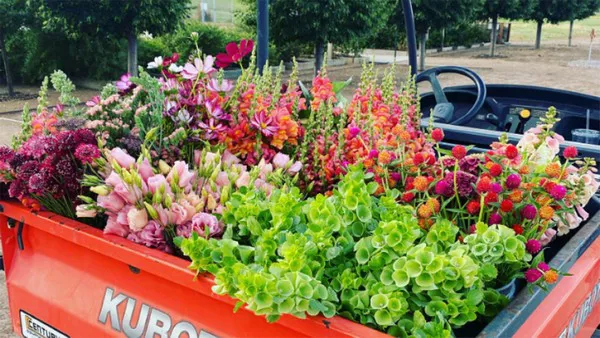Sheridan Hansen is an assistant professor of horticulture at Utah State University Extension. She focuses on urban farming.
"I was a nurse for 15 years actually and decided I needed to get my hands dirty instead of clean and started a small organic farm in East Layton with my mom," said Sheridan Hansen.
They also started a community-supported agriculture program and sold their produce at local farmers' markets. Their niche was growing heirloom and historically significant vegetables.
"Like things that were grown at Monticello or by any of our presidents. Things that helped to feed our nation when it was early on in establishment," said Hansen.

The farm inspired her to go back to school and pursue a career in horticulture, which eventually landed her at USU's Botanical Center in Kaysville - 30,000 to 50,000 thousand people visit the center every year.
There, she started the Urban Demonstration Garden, a 1/8-acre garden designed to maximize the number of vegetables and fruits grown in a small space.
"You definitely can make an impact in your food security growing in a very small space. And the things that you grow, if you were to preserve them, bottle them, and can them, you can really feed your family throughout the season," said Hansen.
With food security in mind, Hansen and the master gardeners at the center apply specialized techniques to increase yields from the garden.
"Things like really heavily cropping an area using vertical trellising. Whatever we can do to get more into that space," said Hansen.
And it's paying off. The garden yields about 5,000 lbs. of vegetables every year.
Combined with the produce from their Edible Demonstration Garden that showcases unique varieties of crops suited to Northern Utah's climate and soil, the center donates 8,000 to 9,000 lbs. of fresh food annually.
"We donate all of the food that is grown on-site. It goes out to needy populations throughout Davis County. So, we were working very closely with food banks," said Hansen.
Food is not the only benefit of the garden. With the cut flower industry in Utah growing, Hansen says they are also researching the kinds and amounts of flowers they can grow in that space.
"Tremendous yields out of the cut flower garden."
Hansen has her pulse on the local farm scene. She helps organize the Urban and Small Farms Conference and works with a lot of micro-scale farmers, which means five acres or less. She says these farms have unique challenges.
"We run into space issues, we run into how 'do I get a tractor in this space, how can I afford a tractor?' There are so many different things that factor into small scale and micro scale agriculture that make them kind of an anomaly when we look at farming."
The majority of these farmers are growing food for the community and distributing it through CSAs, farmer's markets, and other ways. Making a living from it is challenging. Hansen says most of them have second jobs.
"They do this because they love it, not because it necessarily pays the bills, which is a hard spot to be in as a farmer."
One way to combat that and get more out of all that hand labor required to farm on such a small scale, Hansen says, is to grow high-value specialty crops like herbs and the kinds of produce you don't typically see much of at the average farmers market, such as unique varieties of garlic and lettuces, heirloom tomatoes, figs…
"So that you can increase what you are getting out of your vegetable sales. Anything where they can also extend the season, so if we've got enough space to put a high tunnel over that crop and season extend so that you can really impact what timing you have with your yields, and you can either be earlier or later than the average farmer. That will also give you an added boost."
Other strategies giving these farmers a lift include the development of smaller mechanized equipment like small-scale sprayers for fruit and easier ways to cultivate in tight spaces so when planting intensively, instead of having rows with a walkway space in between each one, four or five rows might be squished together.
"You know, it's looking at innovation, it's talking around a table to see what other farmers and growers are doing, those are how we deal with some of the challenges. It's a lot of listening to each other and trying new things," said Hansen.
With water conservation on everyone's minds, hydroponics and its water recycling systems make it one farming practice gaining momentum, and Hansen says it's becoming more affordable.
"Where the cost of LED lighting has come down, it's more economical to grow with artificial light than in years past."
Other strides are being made at the government level. Utah House Bill 390, sponsored by Representative Mike Kohler of Wasatch County, brings greenbelt status to small acreage farms, which allows land to be taxed on its present agricultural use, as opposed to its current market value.
"The taxes for acreage are just astronomical, and that's why we are losing a lot of our farmers," said Hansen.
The good news is Hansen says several counties have already adopted the law.
Progress seems to boil down to conversations and innovations. Hansen points out the ball is rolling and that we all need to stand behind our farmers.
"Our farmers have kind of taken a beating the last little while with water usage, and I would want everyone to know that our farmers are doing their very best to conserve, and if there was ever a time that they needed our support, this is it right now. Visit those farmers' markets because it makes a huge difference in their lives, the lives of their families, and they work so hard, and if I could tell everybody one thing, it would be to support our farmers."
Source: usu.edu
